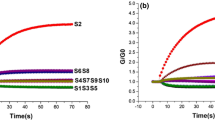Abstract
The responses generated by a gas sensor array are difficult to classify due to their inherent imprecision, uncertainty and the procedures of computational intelligence are appropriate to deal with such imperfect knowledge. In recent years, rough set theory has attracted more attention of many researchers even though it was proposed in the early 1980’s by Z. Pawlak. The rough set based analysis makes it very convenient for classification of data especially with huge volume of information, as the method is very efficient to find the optimal subset of attributes. In this paper, the rough set based algorithm has been applied to generate representative rules using the datasets obtained from a gas sensor array in an electronic nose instrument, capable of sensing aroma of black tea samples and these rules are used to classify the black tea quality.
Access this chapter
Tax calculation will be finalised at checkout
Purchases are for personal use only
Preview
Unable to display preview. Download preview PDF.
Similar content being viewed by others
References
Peris, M., Escuder-Gilabert, L.: A 21st century technique for food control: Electronic noses. Analytica Chimica Acta 638(1), 1–15 (2009)
Guo, D., Zhang, D., Li, N., Zhang, L., Yang, J.: A novel breath analysis system based on electronic olfaction. IEEE Transactions on Biomedical Engineering 57(11), art. no. 5523940, 2753–2763 (2010)
Capua, E., Cao, R., Sukenik, C.N., Naaman, R.: Detection of triacetone triperoxide (TATP) with an array of sensors based on non-specific interactions. Sensors and Actuators, B: Chemical 140(1), 122–127 (2009)
Dutta, R., Hines, E.L., Gardner, J.W., Kashwan, K.R., Bhuyan, M.: Tea quality prediction using a tin oxide-based electronic nose: An artificial intelligence approach. Sens. Actuators B: Chem. 94, 228–237 (2003)
Bhattacharyya, N., Bandyopadhyay, R., Bhyan, M., Ghosh, A., Mudi, R.K.: Correlation of multi-sensor array data with ‘tasters’ panel evaluation for objective assessment of black tea flavour. In: Proc. ISOEN, Barcelona, Spain (2005)
Bhattacharyya, N., Bandyopadhyay, R., Bhuyan, M., Tudu, B., Ghosh, D., Jana, A.: Electronic nose for black tea classification and correlation of measurements with “Tea Taster” marks. IEEE Trans. Instrum. Meas. 57, 1313–1321 (2008)
Bhattacharyya, N., Seth, S., Tudu, B., Tamuly, P., Jana, A., Ghosh, D., Bandyopadhyay, R., Bhuyan, M., Sabhapandit, S.: Detection of optimum fermentation time for black tea manufacturing using electronic nose. Sens. Actuators B, Chem. 122(2), 627–634 (2007)
Tudu, B., Metla, A., Das, B., Bhattacharyya, N., Jana, A., Ghosh, D., Bandyopadhyay, R.: Towards Versatile Electronic Nose Pattern Classifier for Black Tea Quality Evaluation: An Incremental Fuzzy Approach. IEEE Trans. Instrum. Meas. 58(9), 3069–3078 (2009)
Kermani, B.G., Schiffman, S.S., Nagle, H.T.: A novel method for reducing the dimensionality in a sensor array. IEEE Trans. Instrum. Meas. 47(3), 728–741 (1998)
Elkov, T., Martensson, P., Lundstrom, I.: Selection of variables for interpreting multivariate gas sensor data. Anal. Chim. Acta 381, 221–232 (1999)
Pawlak, Z.: Rough set theory and its applications to data analysis. Cybernetics and Systems: An Int. J. 29, 661–688 (1998)
Pawlak, Z.: Some Issues on Rough Sets. In: Peters, J.F., Skowron, A., Grzymała-Busse, J.W., Kostek, B., Świniarski, R.W., Szczuka, M.S. (eds.) Transactions on Rough Sets I. LNCS, vol. 3100, pp. 1–58. Springer, Heidelberg (2004)
Komorowski, J., Polkowski, L., Skowron, A.: Rough Sets: A Tutorial, Rough Fuzzy Hybridization, pp. 3–98. Springer (1999)
Nguyen, S.H., Nguyen, H.S.: Pattern extraction from data. Fundamental Informaticae 34, 129–144 (1998)
Hussain, F., Liu, H., Tan, C.L., Dash, M.: Discretization: An enabling technique. Data Min. Knowl. Dis. 6, 393–423 (2002)
Dai, J.-H., Li, Y.-X.: Study on discretization based on rough set theory. In: Proc. of the First International Conference on Machine Learning and Cybernetics, Beijing, pp. 1371–1373 (November 2002)
Yang, P., Li, J., Huang, Y.: An attribute reduction algorithm by rough set based on binary discernibility matrix. In: Proc. of the Fifth International Conference on Fuzzy Systems and Knowledge Discovery, pp. 276–280 (2008)
Li, J., Pattaraintakorn, P., Cercone, N.: Rule Evaluations, Attributes, and Rough Sets: Extension and a Case Study. In: Peters, J.F., Skowron, A., Düntsch, I., Grzymała-Busse, J.W., Orłowska, E., Polkowski, L. (eds.) Transactions on Rough Sets VI. LNCS, vol. 4374, pp. 152–171. Springer, Heidelberg (2007)
Kovacs, E., Ignat, I.: Reduct equivalent rule induction based on rough set theory. In: Proc. IEEE 3rd International Conference on Intelligent Computer Communication and Processing, pp. 9–15 (2007)
Bag, A.K., Tudu, B., Roy, J., Bhattacharyya, N., Bandyopadhyay, R.: Optimization of sensor array in electronic nose: a rough set-based approach. IEEE Sensors Journal 11, 3000–3008 (2011)
Rodriguez, J.D., Perez, A., Lozano, J.A.: Sensitivity Analysis of k-Fold Cross Validation in Prediction Error Estimation. IEEE Trans. Pattern Anal. Mach. Intel. 32(3), 569–575 (2010)
Singh, S., Hines, E.L., Gardner, J.W.: Fuzzy neural computing of coffee and tainted-water data from an electronic nose. Sens. Actuators B 30(3), 185–190 (1996)
Author information
Authors and Affiliations
Corresponding author
Editor information
Editors and Affiliations
Rights and permissions
Copyright information
© 2013 Springer-Verlag Berlin Heidelberg
About this paper
Cite this paper
Bag, A.K., Tudu, B., Bhattacharyya, N., Bandyopadhyay, R. (2013). Rough Set Based Classification on Electronic Nose Data for Black Tea Application. In: Meghanathan, N., Nagamalai, D., Chaki, N. (eds) Advances in Computing and Information Technology. Advances in Intelligent Systems and Computing, vol 178. Springer, Berlin, Heidelberg. https://doi.org/10.1007/978-3-642-31600-5_3
Download citation
DOI: https://doi.org/10.1007/978-3-642-31600-5_3
Publisher Name: Springer, Berlin, Heidelberg
Print ISBN: 978-3-642-31599-2
Online ISBN: 978-3-642-31600-5
eBook Packages: EngineeringEngineering (R0)




